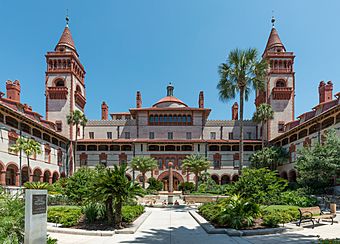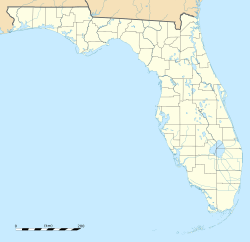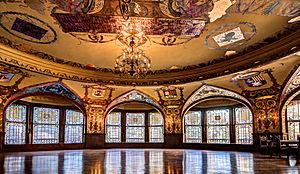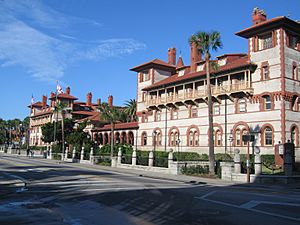Ponce de Leon Hotel facts for kids
|
Ponce de León Hotel
|
|
|
U.S. National Historic Landmark District
Contributing Property |
|

The Ponce de León Hotel, today Flagler College
|
|
| Location | 74 King Street St. Augustine, Florida, US |
|---|---|
| Built | 1885–1887 |
| Architect | John M. Carrere and Thomas Hastings |
| Architectural style | Spanish Colonial Revival architecture |
| NRHP reference No. | 75002067 |
Quick facts for kids Significant dates |
|
| Added to NRHP | May 6, 1975 |
| Designated NHL | February 17, 2006 |
| Designated NHLDCP | April 15, 1970 |
The Hotel Ponce de Leon, also known as The Ponce, was a fancy hotel in St. Augustine, Florida. A rich businessman named Henry Flagler, who helped start Standard Oil, built it. The hotel was built between 1885 and 1887 and opened in January 1888. It was a winter getaway for wealthy people.
The hotel was designed in a style called Spanish Renaissance Revival. It was the first big project for the architecture firm Carrère and Hastings. They later became famous for designing many buildings, including the New York Public Library.
The Ponce de Leon Hotel was special because it was one of the first large buildings made entirely of poured concrete. It also had electricity from the very beginning. Thomas Edison, a friend of Henry Flagler, helped set up the power system. Since 1968, the hotel building and its grounds have been the main part of the Flagler College campus.
Contents
Building the Hotel
Henry Flagler's Vision
Henry Flagler visited St. Augustine in 1882 and loved the historic city. He saw that it could be a great place for a winter resort for rich people from the North. He was very impressed by a house called Villa Zorayda, which was built using poured concrete.
In 1885, Flagler decided to build a hotel himself. He started building the 540-room Ponce de Leon Hotel. It ended up costing much more than he first thought.
Design and Construction Details
The Hotel Ponce de Leon was built on land that used to be an orange grove. Construction started in 1885 and finished in 1887.
Many famous designers and artists worked on the hotel. The main architects were John Carrère and Thomas Hastings. The inside of the hotel was designed by Louis Comfort Tiffany, whose company, Tiffany & Co., made the beautiful stained glass windows in the dining room.
The hotel was one of the first buildings in the world to be wired for electricity. Thomas Edison, who was friends with Henry Flagler, helped set up the electrical system. When the hotel first opened, guests were scared to turn the electric switches on and off themselves, so Flagler hired staff to do it for them!
The two tall towers of the hotel actually held large water tanks. Each tank could hold 8,000 gallons of water, giving guests running water in their rooms.
Hotel Life and Famous Guests
Opening and Growth
The Hotel Ponce de Leon opened on January 10, 1888, and was an instant hit. It was so popular that Flagler soon opened another hotel nearby, the Alcazar, to handle all the guests.
Flagler realized that good transportation was needed to bring guests to his hotels. So, he bought several small railroads and combined them to create the Florida East Coast Railway. He made the railroads better so that guests could travel easily from New York City and other northern cities to St. Augustine. Over the next 20 years, Flagler extended the railway all the way to Key West.
Notable Visitors
Many famous people stayed at the Hotel Ponce de Leon. These included presidents like Grover Cleveland, Theodore Roosevelt, and Warren G. Harding. Even future presidents Franklin D. Roosevelt (as a college student) and John F. Kennedy (as a child) visited. Other well-known guests included writer Mark Twain and sports legends Babe Ruth and Babe Didrikson.
The hotel's headwaiter in the late 1800s was Frank Thompson. He was a leader in civil rights and helped organize a professional Black baseball team called the Cuban Giants.
Challenges and Changes
In the 1910s and 1920s, fewer people visited the hotel. This was partly because Flagler's railway kept extending further south. This allowed tourists to go to even warmer places like West Palm Beach and Miami. Even though other hotels closed, the Ponce de Leon stayed open through the Great Depression.
Art and War History
An Artists' Hub
Henry Flagler created an art colony at the hotel, with a special building for artists' studios. Many rising American artists came to work there. One famous artist, Martin Johnson Heade, painted his well-known "Giant Magnolias on a Blue Cloth" in one of these studios. This painting is now in the National Gallery of Art in Washington, D.C.
During the Great Depression, the government helped St. Augustine to boost tourism. Many famous writers, like Ernest Hemingway and Zora Neale Hurston, visited or lived in the city, adding to the lively art scene.
World War II Training Center
During World War II, the U.S. government took over the Ponce de Leon Hotel. It was used as a training center for the United States Coast Guard. St. Augustine is considered the birthplace of the United States Coast Guard Reserve. Thousands of young recruits received their training at the hotel from 1942 to 1945. Up to 2,500 trainees lived in the building at one time.
One of the Coast Guardsmen who trained there was Jacob Lawrence, who was already a famous artist. Even though he was in the Coast Guard, his commanding officer encouraged him to keep making art. Jacob Lawrence later became the first African-American artist to have his works displayed in both the Vatican and the White House.
From Hotel to College
After World War II ended, the Coast Guard left, and the building became a hotel again. Many tourists returned, but this boom didn't last. The hotel saw fewer and fewer visitors over the years, and it finally closed for good in 1967.
In 1968, the former hotel became the main building for the new Flagler College. Since 1976, the college has worked hard to restore the hotel and other old buildings to their original beauty. Students at Flagler College now give guided tours of the former hotel to thousands of visitors every year.
The building was added to the U.S. National Register of Historic Places in 1975. It became a U.S. National Historic Landmark on February 21, 2006, which means it's a very important historic place.
Gallery
Images for kids
See also
 In Spanish: Hotel Ponce de León para niños
In Spanish: Hotel Ponce de León para niños











